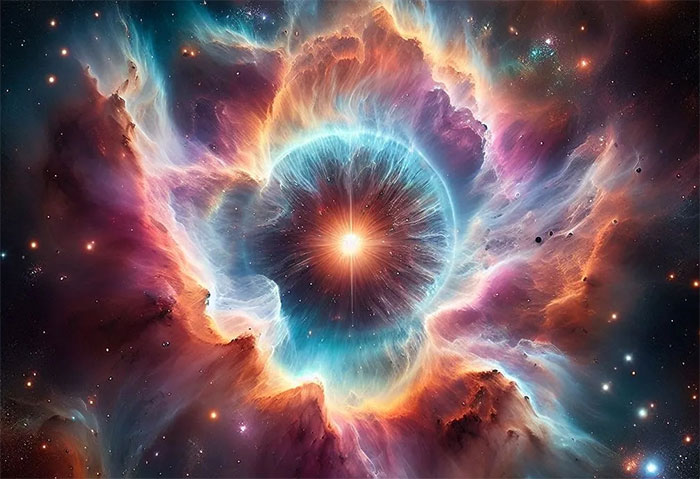Finding the 'cosmic death zone' where Earth life may have been born
An experiment targeting the chaotic and dead regions of the universe could help explain the origin of life on Earth.
A team of scientists from the Canary Institute of Astrophysics (IAC - Spain) conducted experiments on how "life cages" called fullerenes are created in the universe.
Fullerenes are spherical carbon cages capable of carrying complex compounds inside, traveling great distances through the harsh environment of interstellar space.
According to Science Alert, scientists have discovered the existence of fullerenes around dusty, chaotic regions around planetary nebulae.
Planetary nebula is a misnomer for the remnants of old, dead, and exploding stars.

Planetary nebulae are remnants of dead stars - (Graphic image).
Simulations based on a planetary nebula, Tc 1, have confirmed that in the chaotic, dead zone around these nebulae, fullerenes form through hydrogenated amorphous carbon particles.
Confirming how fullerene worked, scientists also indirectly confirmed how life might have arrived on Earth in the distant past, as well as where that life originated.
Clearly, complex, intense processes in "death zones" such as nebulae contribute to the existence of complex molecules.
Then, through fullerene cages created on site, prebiotic molecules - which are thought to be very fragile - were protected to travel through space full of deadly interstellar radiation.
With luck, these life cages find their way to a young, forming star, releasing the seeds of life it carries into that star's protoplanetary disk.
And if that young star is lucky enough to create a few planets suitable for life like Earth, pre-biotic molecules will be seeded and gradually evolve to create a world with new life.
That is the path that the seeds of life of ourselves and all species on Earth have taken in the past.
Therefore, this new research result contributes another important piece of the puzzle to astrobiologists' big dream of recreating how life on Earth began in interstellar space.
The results have just been published in the scientific journal Astronomy & Astrophysics.
- Cosmic meteorite originated from ... Earth
- Cosmic disasters can put humanity at risk
- Discovered the most dangerous region of death on Earth: 'Monster Sanctuary'
- Can aliens live without water?
- 'Death zone' reappears in the United States
- When did life on Earth really begin?
- Are there more 'livable' planets than Earth?
- Life on Earth will be destroyed after 3 billion years
- Analyzing cosmic matter, finding Earth's first human?
- Scientists think that these are the eight most likely cases of life eradication
- 'Rise' of death in Siberia threatens planet life
- Earth life originates from cosmic bacteria
 Discovered an ancient centipede fossil 99 million years old
Discovered an ancient centipede fossil 99 million years old Discovered bat-like dinosaurs in China
Discovered bat-like dinosaurs in China Discovered a 200-year-old bronze cannon of the coast
Discovered a 200-year-old bronze cannon of the coast Discover 305 million-year-old spider fossils
Discover 305 million-year-old spider fossils